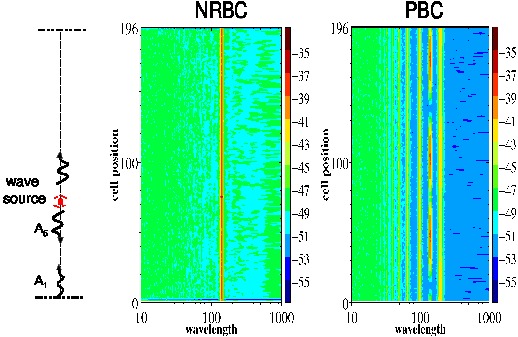Fluctuating hydrodynamics
Fluctuating hydrodynamics for realistic liquid models
A good representation of mesoscopic fluids is required to complement
molecular simulations at larger scales. However, computational
models providing accurate and efficient description of hydrodynamics
at the nanoscale are scarce, possibly because of the stochastic
character of the underlaying flucutating hydrodynamics (FH)
equations. Here, we derive a simple finite volume discretization
over a regular grid of the compressible isothermal fluctuating
hydrodynamics equations in the Eulerian reference system. We
describe realistic fluids, such as
argon at arbitrary densities and
water (TIP3P model) at ambient conditions (T=300 K). To that end,
molecular dynamics simulations are used to derive the required fluid
properties: transport coefficients and pressure equation of
state. The equilibrium state of the model is shown to be
thermodynamically consistent and shown to correctly reproduce linear
hydrodynamics (relaxation of sound and shear modes). We also
consider non-equilibrium states involving diffusion and convection,
in cavities with either slip or no-slip boundary conditions.
G. De Fabritiis, M. Serrano, R. Delgado-Buscalioni and P. V. Coveney , Fluctuating hydrodynamic modeling of
fluids at the nanoscale, Phys. Rev. E, 75, 026307 (2007)
Coworkers:
Gianni De Fabritiis
Fluctuating hydrodynamics in staggered grids
In collaboration with Aleks Donev and the group of Charles Peskin we have recently developed
a third order Runge Kutta algorithm in a staggered grid to solve fluctuating hydrodynamics of ideal mixtures.
Implementations for both compressible and incompressible fluids are now available.
GPU solvers
The algorithms have been written in CUDA to work in Graphical Processors Units. The computational efficiency
has been sppeded up a factor 100 over single CPU processors.
Staggered Schemes for Fluctuating Hydrodynamics , F. Balboa, J. Bell, R. Delgado-Buscalioni, A. Donev, T. Fai, B. Griffith, C. S. Peskin (2011)
Coworkers:
Florencio Balboa Usabiaga (UAM)
Aleks Donev (Courant Institute of New York) ,
Open boundary conditions for fluctuating hydrodynamics
Non-reflecting boundary conditions (NRBC) are designed to
evacuate sound waves out of the computational domain, thus allowing to deal
with open systems and to avoid finite size effects
associated with periodic boundaries . Thermodynamic consistency for the
fluctuation of the total mass and momentum of the open system is
ensured by a fluctuation-dissipation balance which controls the
amplitude of the sound waves generated by stress fluctuations near the
boundary. We consider equilibrium and out-of-equilibrium situations
(forced sound) in liquid water at ambient conditions and argon
ranging from gas to liquid densities. Non-reflecting boundaries for
fluctuating hydrodynamics makes feasible simulations of ultrasound in
microfluidic devices. The figure shows the power spectra of density waves in a simulation box
with an oscillatory forcing at one point. Periodic boundaries (PBC) arecontaminated by spurious (eigen) modes of the box,
while using NRBC, only the exicted wave appears.
Coworer:
Anne Dejoan (CIEMAT)
Some papers
R. Delgado-Buscalioni, A. Dejoan, Non-reflecting boundaries for ultrasound in fluctuating hydrodynamics
of open systems, Phys. Rev. E 78, 046708 (2008)


